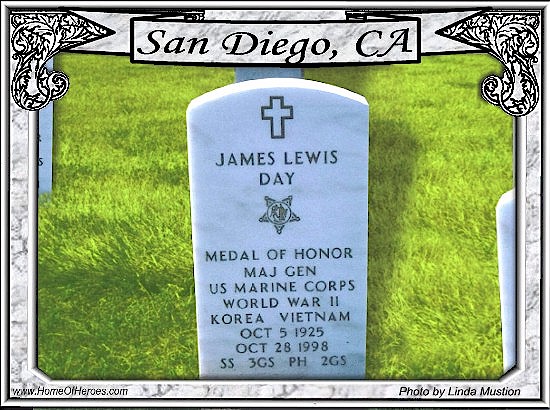Intro
Geography
U.S. Military
Politics & Struggle
Sounds of Okinawa
My Scrapbook
VIDEO Tours
Web-cams
In the News
My Library
Mail Bag
Links
Oki Stories

|
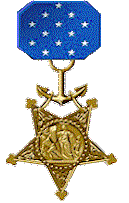
For conspicuous gallantry and intrepidity at the risk of his life above and beyond the call of duty as a squad leader serving with the Second Battalion, Twenty-Second Marines, Sixth Marine Division, in sustained combat operations against Japanese forces on Okinawa, Ryukyu Islands from 14 to 17 May 1945.
On the first day, Corporal Day rallied his squad and the remnants of another unit and led them to a critical position forward of the front lines of Sugar Loaf Hill. Soon thereafter, they came under an intense mortar and artillery barrage that was quickly followed by a ferocious ground attack by some forty Japanese soldiers. Despite the loss of one-half of his men, Corporal Day remained at the forefront, shouting encouragement, hurling hand grenades, and directing deadly fire, thereby repelling the determined enemy. Reinforced by six men, he led his squad in repelling three fierce night attacks but suffered five additional Marines killed and one wounded, whom he assisted to safety.
Upon hearing nearby calls for corpsman assistance, Corporal Day braved heavy enemy fire to escort four seriously wounded Marines, one at a time, to safety. Corporal Day then manned a light machine gun, assisted by a wounded Marine, and halted another night attack. In the ferocious action, his machine gun was destroyed, and he suffered multiple white phosphorous and fragmentation wounds. He reorganized his defensive position in time to halt a fifth enemy attack with devastating small arms fire. On three separate occasions, Japanese soldiers closed to within a few feet of his foxhole, but were killed by Corporal Day.
During the second day, the enemy conducted numerous unsuccessful swarming attacks against his exposed position. When the attacks momentarily subsided, over 70 enemy dead were counted around his position. On the third day, a wounded and exhausted Corporal Day repulsed the enemy's final attack, killing a dozen enemy soldiers at close range. Having yielded no ground and with more than 100 enemy dead around his position, Corporal Day preserved the lives of his fellow Marines and made a significant contribution to the success of the Okinawa campaign.
By his extraordinary heroism, repeated acts of valor, and quintessential battlefield leadership, Corporal Day inspired the efforts of his outnumbered Marines to defeat a much larger enemy force, reflecting great credit upon himself and upholding the highest traditions of the Marine Corps and the United States Naval Service.
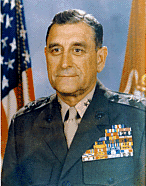
CATHEDRAL CITY, Calif. (A.P.) James L. Day, 73, a retired Marine Corps general who won the Medal of Honor, the nation's highest award for valor, for holding his ground on Sugar Loaf Hill during World War II, died here Oct. 28, 1998 after a heart attack.
He received the Medal of Honor from President Clinton on Jan. 20, more than a half-century after he was recommended for the honor for his role in the May 1945 battle for Sugar Loaf Hill on the Japanese island of Okinawa.
During the battle, the 19-year-old future general fought virtually alone from his foxhole and yielded no ground despite his own shrapnel wounds and white phosphorous burns.
After two days and two nights of fighting, the enemy dead around his foxhole numbered more than 100.
At the medal ceremony, Clinton said Gen. Day's heroism played a crucial part in holding Sugar Loaf. "That success opened the way to the capture of Okinawa and the ultimate triumph of the forces of freedom in the Pacific," Clinton said.
The paperwork for his medal was lost in the chaos of the battlefield but resurfaced in 1980 when a retired Marine found faded carbon copies of the recommendation among his World War II memorabilia. It took an additional 18 years for the paperwork to reach the appropriate officials.
In the years after World War II, Gen. Day oversaw combat troops in Korea and Vietnam. He also held commands in Japan, San Diego, Washington, Okinawa and at Camp Pendleton.
His 31 other military decorations included three Silver Stars, a Bronze Star, six Purple Hearts and two Navy Commendation Medals.
After retiring from the Marines, Gen. Day was chancellor of the National University campus in Palm Springs, Calif., and partner in a construction company.
WASHINGTON-President Clinton expressed sadness Monday November 2, 1998 at the death of Marine Corps Gen. James L. Day, who was awarded the Medal of Honor in a White House ceremony last January.
"We will miss this true hero, whose selfless conduct as a Marine and citizen set a shining example for all Americans," Clinton said in a written statement. "We are grateful for all he did to preserve the freedom that is our most sacred gift."
Day, who was 73, died October 28, 1998 of a heart attack.
Clinton presented Day with the Medal of Honor last Jan. 20, more than a half-century after he was recommended for the honor for his role in the World War II battle for Sugar Loaf Hill on the Japanese island of Okinawa in May 1945.
The paperwork for his medal was lost in the chaos of the battlefield, but resurfaced in 1980 when a retired Marine found faded carbon copies of the recommendation among his World War II memorabilia. It took 18 more years for the paperwork to reach the appropriate officials.
The 19-year-old Day fought virtually alone from his foxhole and yielded no ground despite his own shrapnel wounds and white phosphorous burns. After two days and two nights of fighting, the enemy dead around his foxhole numbered more than 100.
|
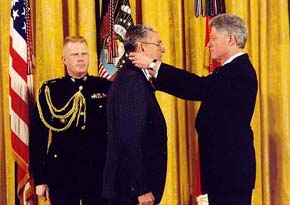
Pacific Stars and Stripes
Monday, January 19, 1998
Vet to get top medal 53
years after deeds
BY DAVID ALLEN
Stripes Okinawa Bureau Chief
CAMP FOSTER -- James L. Day doesn't consider himself
a hero.
A career in the Marine Corps that spanned three wars taught
him that heroes are usually common men who rise to meet
uncommon challenges. And most heroics go unnoticed,
usually because no one is left to tell their tale.
Even so, the retired Marine major general is pleased to be
receiving the Medal of Honor nearly 53 years after the most
harrowing days of his life, which occurred during the Battle
of Okinawa.
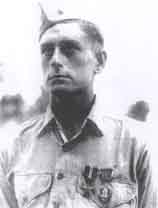
He will receive his award from President Clinton during a
ceremony Tuesday at the White House.
On May 14, 1945, Day was the leader of a fire team with
Weapons Company, 22nd Marine Regiment, 6th Marine
Division. He led 11 men, the remnants of two squads, up the
western slope of a squat hill on the approach to the
bombed-out ruins of Naha. Only two of the men survived.
They called the hill Sugar Loaf. Conquering it would cost the
blood of many good men. Over a period of seven days,
starting May 12, 6th Marine Division suffered 2,662
casualties. Another 1,289 required treatment for battle
fatigue.
The hill changed hands 14 times before the Marines finally
held it.
``There was only two of us from my old platoon -- me and
Pfc. Dale Bertoli,'' Day said from his home in Cathedral
Heights, Calif., in a telephone interview. ``The others were
replacements from an other platoon. I was told by my
lieutenant to take a position on the far right side of the hill.
There was heavy artillery and mortar fire and three or four
attacks on our position that day.''
Six of the Americans were killed. Two were wounded. That
left just Day and Bertoli, both experienced in combat, and a
replacement named McDonald. They took up a position in a
deep shell hole.
Day did not realize that the main Marine thrust up Sugar
Loaf that day had been repulsed. The three men in Day's
shell hole were the only Americans left on the hill.
``It was a real good position, though,'' Day remembered.
``In order for any Japanese in our area to assault our line,
they had to come across us.''
For the rest of the 14th, Day and his two companions fought
off several Japanese attacks with grenades, a machine gun
and a rifle. ``They sent groups of 15 to 20 people at our
position all night long,'' Day said. ``No one got any sleep.
``One thing in our favor was at the base of Sugar Loaf,
about 30 yards behind us, two of our amtracs (amphibious
tractors) had been knocked out,'' he said. ``They were full of
ammo, particularly with grenades.''
On May 15, an anti-tank round killed McDonald. Bertoli
was violently ill with dengue fever. ``He couldn't use his
hands to fire his weapon,'' Day said. ``But somehow he
could carry ammo.''
Other Marines' statements just after the battle attest to the
attacks' ferocity and Day's tenacity in repelling them.
Sgt. Narolian H. West was in the shell hole briefly to treat
and retrieve the wounded: ``As soon as we reached that
position, we came under attack. The squad leader was the
only one firing his weapon and throwing grenades. Myself
and two other men with me did not have weapons, as we
were trying to bandage and attend to the wounded. I heard
someone yell and as I looked up three Japanese soldiers
were coming over the parapet.
``The squad leader, who I later learned was Cpl. Day, killed
all three of the Japanese with his rifle, and they fell on top of
me and another man,'' West said. ``The corporal was
everywhere. He would run from one spot to another, trying
to get more fire into the enemy. ... If it had not been for Cpl.
Day's bravery, none of us would have made it out alive.''
Day said he heard someone yelling for a corpsman on the
morning of May 16. He found four Marines in a hole about
40 feet away. ``We got them back to our hole. There were
small attacks and probes all day long. The Japanese were
trying to get through us so they could get at our tanks in the
rear area.''
The four new Marines were killed.
``Finally, on the 17th, we were relieved,'' Day said.
``Someone later counted all the enemy bodies around our
hole. There were at least 158 bodies.''
Day said he had been through Japanese attacks just as
intense on Eniwetok and Guam, ``but there I had a whole
company around me.''
He survived Sugar Loaf because of his experience. ``Not a
man in the regiment had more combat experience than me,''
he said. ``Me and Bertoli knew our weapons and knew it
was better to stay put than get up and try to withdraw. We
knew our job was to survive. We couldn't worry about a
half-hour in the future, let alone what was going on
elsewhere.''
Bertoli recovered from his illness, but was shot in the neck
on June 8 and died four days later on a hospital ship.
Day received a Bronze Star for other action at Sugar Loaf
and knew, about two days after the hill finally was taken, that
he had been recommended for the Medal of Honor.
``I know quite a few statements had been taken, and the
battalion commander approved it,'' Day said. ``He died two
days later and, frankly, I never took any steps to pursue the
matter. It just fell through the cracks.''
Then, about two years ago, his former company
commander, Capt. Owen Stebbins, called him. Stebbins was
pursuing belated awards for men who had been in his
command. Before he died in 1996, he found the officer who
had investigated Day's case in 1945. The recommendation
was resubmitted.
Part of the original citation reads: ``Giving no ground to the
enemy, Cpl. Day contributed greatly to the success of the
Okinawa campaign. His unwavering devotion to duty
throughout the devastating conflict, and his valiant spirit and
resolute self-sacrifice reflect the highest credit upon himself
and the United States Naval Service.''
Day joined the Marine Corps at 17 in 1943. He saw action
in Guam and the Marshall Islands before landing on
Okinawa on April 1, 1945, as a squad leader.
After the war, he remained in the corps, attaining the rank of
gunnery sergeant before being commissioned as a second
lieutenant in 1952. He returned to Okinawa four times
before becoming commanding general of Marine bases in
Japan from 1984 to 1986.
While commander, Day became involved with the Ryukyu
America Historical Research Society on Okinawa and was
instrumental in the return of several major Okinawan artifacts
from the United States, including many war trophies taken by
U.S. servicemen during the Battle of Okinawa. He remains
the society's honorary president.
When Day retired in 1986, he was the last active-duty
Marine who had served as a combat infantryman in World
War II, Korea and Vietnam. He is believed to be the only
Marine infantryman to have been wounded and decorated
for valor in all three wars, according to the Marine Corps.
Besides the Medal of Honor, his decorations include the
Distinguished Service Medal, three Silver Stars, the Defense
Superior Service Medal, the Legion of Merit Medal with a
combat ``V,'' the Bronze Star with a combat ``V,'' two Navy
Commendation Medals with combat ``V's'' and six Purple
Hearts.
|




